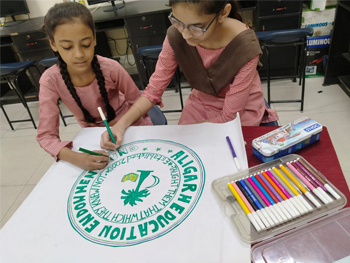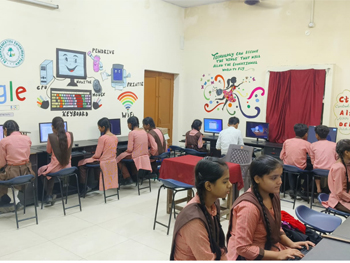AEEF
Aligarh Education Endowment FundA Non-Profit 501 (c) (3) Educational
& Charitable Organization Tax ID: 20-1000034
(650) 969-AEEF (2333)
Mail us 
VOCATIONAL/COMPUTER TRAINING
Digital Literacy for School Children
Project Name: Digital Literacy for School Children in Moradabad
Year Established: 2022
Supported By: Aligarh Education Endowment Fund (AEEF)
Run in Collaboration With: ALIG Educational and Welfare Society.

Project Objectives
- Enhance Digital Access:
Provide digital content to children in underserved communities to improve educational opportunities. - Strengthen Educational Infrastructure:
Equip Govt schools with the necessary digital infrastructure and technology-based curricula. - Improve Learning Outcomes:
Utilize digital education to enhance the quality of learning and bridge the educational gap in marginalized communities.

Logic Behind Establishment
In today’s increasingly digital world, computer skills have become crucial for both education and employment. However, many children, especially from underprivileged communities, lack access to the resources and education needed to develop these skills. This project aims to bridge that gap by offering students the opportunity to learn essential digital literacy skills, which serve as a stepping stone for future opportunities in a tech-driven job market.
By fostering digital literacy from an early age, the project seeks to:
- Empower children to use technology responsibly and effectively.
- Build a strong foundation in digital tools such as word processing, data management, basic coding, and internet usage.
- Develop problem-solving and critical thinking skills using digital resources.
- Prepare students for further education and potential careers in technology, information systems, or other fields where digital competence is critical.
Intended Beneficiaries
The project is designed for children between the ages of 6to 14, with a focus on underserved and marginalized communities where access to digital education is limited. The primary beneficiaries are students enrolled in public schools and community learning centers that lack the necessary digital infrastructure or technology-based curricula.
Number of Beneficiaries
Since its launch in 2022, the project has reached around 350 children annually. By the end of 2025, it is expected to have directly impacted approximately 1,400 students, with plans to scale up to 2,500 students per year over the next five years.
Recurring Costs After Initial Setup
After the initial investment in infrastructure—including the purchase of laptops, internet setup, and installation of educational software—the project incurs recurring costs for:
- Maintenance of equipment (hardware repairs, software updates)
- Salaries for instructors trained in digital literacy
- Internet and utility expenses at the learning centers
- Curriculum development and updates to stay current with technological trends
The recurring costs are estimated to be around $4,000 annually, covering expenses such as staffing, learning materials, and operational overheads. The initial setup, which involved equipment procurement and facility setup, was estimated at $8000.
Long-term Impact
The project aims to create a sustainable model where students not only gain basic digital skills but also have opportunities to advance into specialized technology courses or internships. Over the next decade, the goal is to equip at least 20,000 students with the skills necessary to pursue careers in tech-related fields, helping to build a digitally literate workforce capable of meeting the demands of the modern economy. By investing in the digital literacy of schoolchildren, the project supports long-term community development and economic empowerment.
Monitoring and Evaluation
Key Performance Indicators (KPIs):
- Number of students accessing digital content
- Improvement in students' academic performance
- Feedback from teachers and parents regarding the impact of digital education
Evaluation Methods:
- Regular assessments and surveys of students’ progress
- Periodic reviews and feedback sessions with educators and community leaders
- Analysis of usage data from digital platforms

